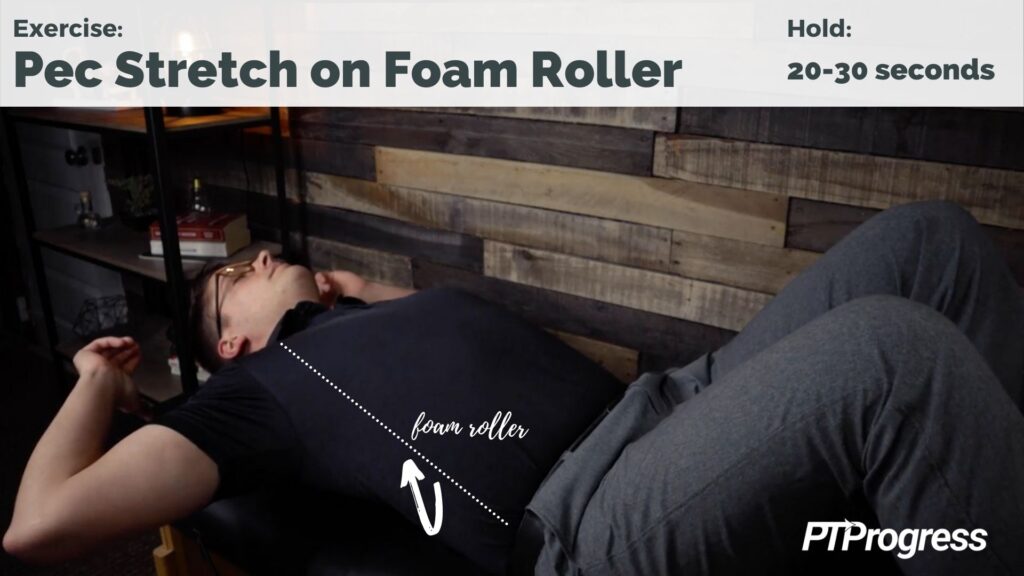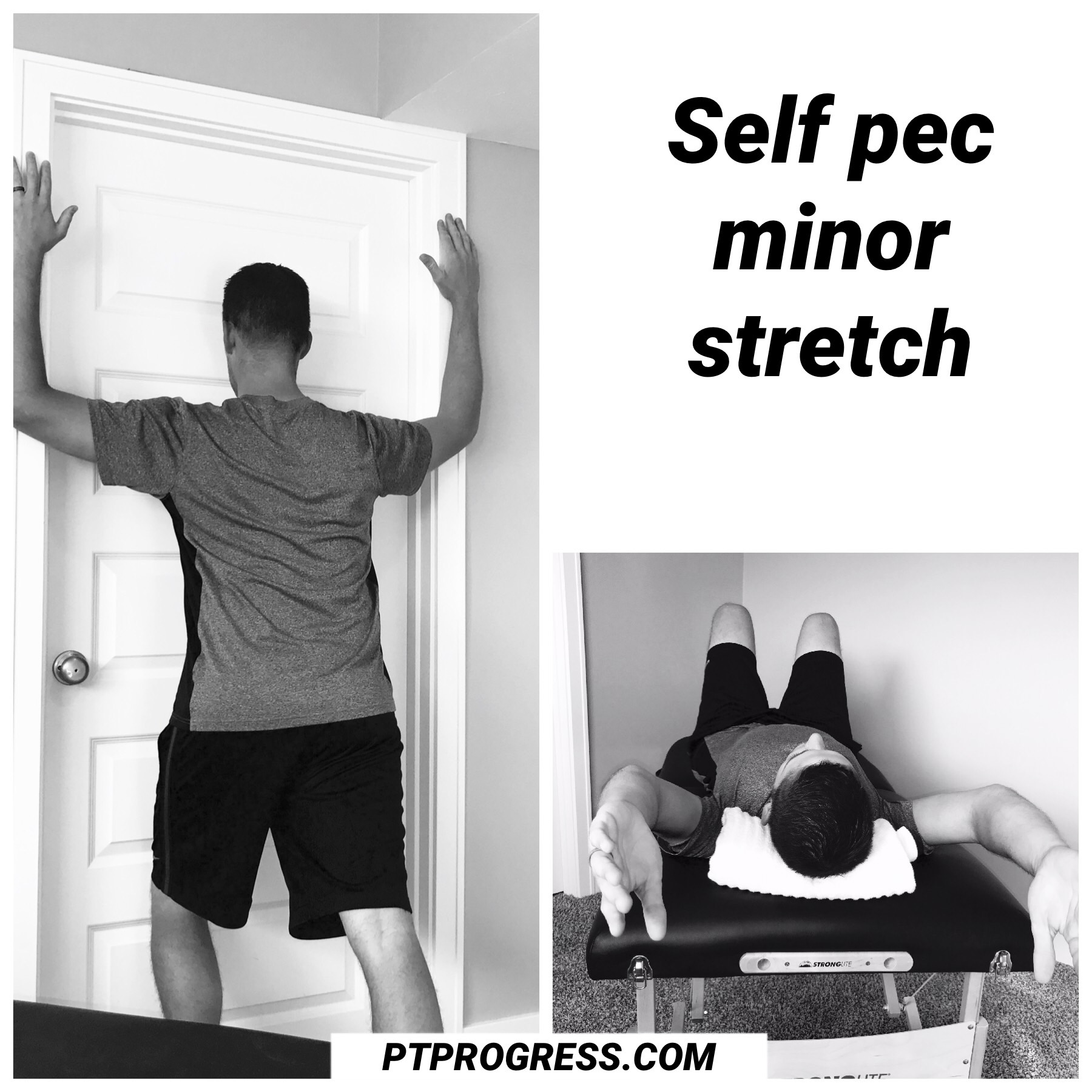
Have you ever noticed in the mirror or in a photo of yourself that you have a slight hump at the back of your neck? This hump is called a “dowager’s hump,” and it’s extremely common. In this post, I’ll show you 9 of the best exercises you can do daily to help decrease the size of your dowager’s hump.
Below are 9 exercises I recommend for getting rid of a dowager’s hump and reversing that hunchback posture.
9 Exercises to Fix a Dowager’s Hump
There are three main ways to address a postural issue such as a neck hump: mobilization, stretching, and strengthening.
So the first part of your workout will focus on loosening up that tight spot in the back of your neck. You’ll then stretch the tight muscles at the heart of the issue and finish with some exercises that will strengthen your muscles and promote good posture.
Here’s the overview of the exercises:
Part 1: Thoracic Mobility
15-20 repetitions, 3-4 times a day
- Thoracic Mobility: towel and chair
- Thoracic extension with foam roller
- Wall rotation and extension
Part 2: Stretches
Hold for 20-30 seconds, 3-4 times a day
- Supine Pec Stretch
- Wall Angel Active Stretch
- Pec Doorway Stretch
Part 3: Strengthening Exercises:
15-20 repetitions, 3-4 times a day
- IYTL
- Supine Chin Tucks
- Banded Diagonals
Now let’s look at each element of this routine one by one.
Part 1: Mobility
There are a couple ways to work on thoracic mobility; try to do at least one of these every day if you can.
Thoracic Mobility Drill
The first way is to use a chair with a solid back. Sit down and place a towel behind your back over the top of the chair. Next, cross your arms and extend your spine into the towel or chair for 1-2 seconds, repeating the movement 15-20 times.
For a deeper stretch in your chest, you can open your arms wide and place your hands behind your head, as I’m doing in the gif above. But if you’re just starting out, I recommend sticking to the crossed-arms version.
Thoracic Extension
For a variation of this drill, grab a foam roller or roll up a towel. Lie down on a flat surface and place the roller or towel horizontally below your shoulder blades. Using the same technique, extend your spine into and over the foam roller 10-15 times.
Be sure to work into the movement gradually, because you’re probably really stiff in your upper back. Eventually, you’ll notice that you can stretch further and further with less discomfort.
Doorway Rotation/Extension
This gentle rotation uses the stability of a wall or door frame to open up the chest and activate the shoulder muscles.
Stand near the doorway with your hand flat against the door frame at shoulder height or just below. Step away from the door, keeping your hand planted on the door frame and your arm outstretched. You may already feel a stretch just holding your arm out straight, but to deepen it, slightly rotate your trunk away from your hand.
Hold the stretch for 20-30 seconds, and repeat 5 times on each side.
Part 2: Stretches
You know what makes poor posture worse? Tight muscles. If your chest muscles are tight, they will pull your shoulders inward and perpetuate poor posture.
You can target these tight muscles and reverse your rounded shoulders with a few key stretches.
Supine Pec Stretch
To perform a pec stretch, you’ll need that foam roller again. This time, lie down on the foam roller lengthwise, so it’s directly in line with your spine.
Hover your arms above the floor in line with your shoulders, elbows bent and palms up. Hold this position for 20-30 seconds as you allow gravity to stretch those tight chest muscles.

Pec Doorway Stretch
Another way to reverse shoulder protraction is a pec doorway stretch. This standing stretch is best done in a corner or doorway – hence the name.
Stand facing the doorway in a shallow lunge, with one foot in front of the other. Place your hands on either side of the corner or door frame with your elbows at shoulder height. Lean forward so that your weight shifts to the front leg, keeping your head neutral. It shouldn’t take much for you to feel a gentle stretch in your pecs.
Hold this stretch for 15-20 seconds for 4-5 repetitions.
Reverse Wall Slide
The next stretch – which is more like an active stretch – is also best done against a wall. That’s why we call it a “wall angel” or reverse wall slide.
Stand with your back against the wall and your arms in a “goal-post” position. The goal here is to keep the back of your arms in contact with the wall as you slide your arms up, overhead, then back down.
It’s ok to cushion your head with a folded towel if you’re having difficulty maintaining perfect posture. You may struggle to keep the back of your arms against the wall behind you, but that’s ok too. Just keep working on the movement until it becomes easier and easier. Eventually you’ll be able to touch the wall and stand up tall!
After a couple weeks of steady improvement, advance the exercise by using a resistance band. Simply loop the band underneath your armpits around your back and hold one end in each hand as you repeat the wall slide movement.
This extra resistance will target your scapular stabilizer muscles even more and help you to eventually raise your arms without lifting your head forward.
Part 3: Strengthening Exercises
Now that you’ve worked on mobilizing the thoracic spine and stretching tight chest muscles, your next step is to strengthen the muscles that keep you upright.
I, Y, T, L
The first exercise is called an I, Y, T, L. If you aren’t familiar with it, the idea is to make the letters I, Y, T, and L with your arms. Sounds simple, but in order for this to be most effective you need to maintain proper alignment in your neck.
The best way to do this exercise is while standing with your back against the wall. If your head sticks forward a lot from the wall, you may need to tuck a rolled-up towel behind your head to maintain proper alignment as you do these movements.
Start with the letter I: raise both arms straight overhead, then return to the starting position. As you make the letter Y (and hum Village People to yourself), you may start to feel a stretch in your chest and along different muscles in your back. That’s a good sign – you need to stretch and strengthen these muscles in order to correct your rounded shoulders.
Next, bring your arms out to the side to make a T, and squeeze your shoulder blades together as you do it. And finish with external rotation: make two L’s by opening your arms out to either side, elbows at your waist and bent at right angles.
Repeat this cycle of I, Y, T, and L 10 to 15 times, as long as you can maintain good form at the wall.
If this exercise starts to get easy, you can challenge yourself by adding some resistance. Tuck a resistance band behind your back, and while holding either end continue the same movements. For the T and L shapes, you can switch hands and cross the bands in front of you to intensify the opposition.
Supine Chin Tuck
Chin tucks help reverse detrimental forward head posture by strengthening the small muscles in the neck. If these muscles are too weak, the larger neck muscles take over and hold the head too far forward.
To perform a supine chin tuck, lie down on your back with your feet flat and knees bent. While keeping your back straight, gently lower your chin down to your chest so that you have a double chin.
If you feel a slight stretch along the back of your neck, you’re doing it right. Just be careful not to lift your head as you tuck your chin, because this will engage other muscles and counteract your exercise.
To intensify the stretch you feel, gently press down on your chin with your fingers.
3-Way Diagonals
The diagonal band stretch is one of my favorite exercises. It helps straighten a rounded back, strengthen a rotator cuff, and encourage thoracic extension. You’ll feel this in your mid-back, right where you need stronger support.
Grab each end of your band and stretch it diagonally so that your hands go in opposite directions. Switch directions, then finish by stretching the band horizontally across your chest.
As you pull on the band, keep your thumbs up, relax your neck and squeeze your shoulder blades together.
When performed properly and consistently, this three-directional workout will help you strengthen your back muscles and your shoulder muscles.
What is a Dowager’s Hump?
The literal meaning of the term “dowager” is a dignified elderly widow, but you don’t need to fit this demographic to have a neck hump.
In fact, the main cause of dowager hump isn’t age, sex, or widowhood; it’s poor posture. As long as you have consistent poor posture, you could develop a dowager’s hump – whether you’re young, old, male or female. And that hump will certainly make you look older.
The Cause of Neck Hump
A dowager’s hump may be unsightly and frustrating, but at the root of it all is our childhood friend, poor posture. And the progression from slouching to hunching is sneakier than you might expect.
The human head is surprisingly heavy – 11 pounds on average. But your head will become even more of a heavyweight if you jut it out in what’s called forward head posture.
Add rounded shoulders to the mix, and that forward posture will become even more exaggerated. At this point, if you’re not mindful to bring your shoulders back, then you’ll exaggerate the naturally-occuring kyphotic curve in your thoracic spine.
Prolong this poor posture, and your body will eventually adapt. As a way to protect the spine, adipose (fatty) tissue will start to build up at the base of the neck, right around C7. That accumulation of fatty tissue is deemed a “dowager’s hump” and you a homemade hunchback.
Bad News and Good News
Bad news first: this exaggerated curve in your spine and the resulting fatty deposits at the site of your neck hump will only get worse if left unaddressed. If you don’t take action early on, it’ll be much harder to fix your dowager’s hump down the road.
But the good news is that, in most cases, poor posture is reversible. By correcting the cause of the problem (your posture), your body will adjust and you’ll notice the hump decrease and eventually disappear.
Remember: when it comes to physical therapy, good change is gradual change. Through a steady progression of consistent exercise, you’ll cultivate correct posture in your body and eliminate your neck hump.
How to Fix a Dowager’s Hump with Exercise
This trifecta of thoracic mobility, stretching, and strengthening is the best way to reverse a neck hump. Make this routine a daily habit, and your dowager’s hump will go away – and stay away – for good.
Just understand that it takes time to see results. You should start to see some changes in your posture over the next few weeks and months, but it doesn’t happen overnight. Consistency is the key to steady progress and lasting change.


